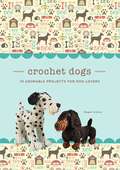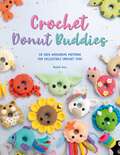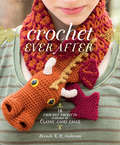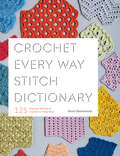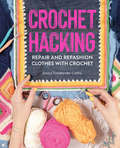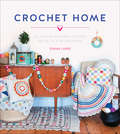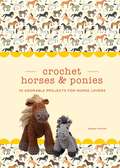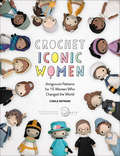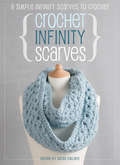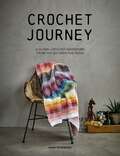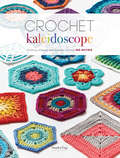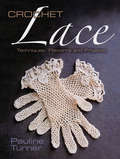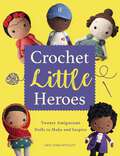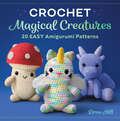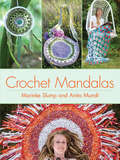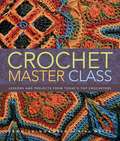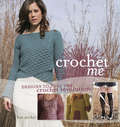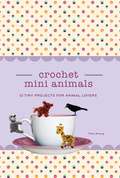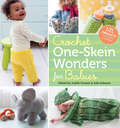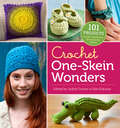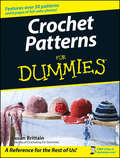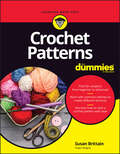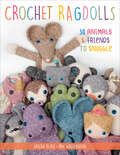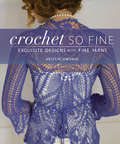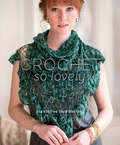- Table View
- List View
Crochet Dogs: 10 Adorable Projects for Dog Lovers (Crochet Kits)
by Megan KreinerYou’ll have a tail-wagging good time making these crochet canines!Crochet a pack of pups in ten different breeds, including a dalmatian, standard poodle, husky, corgi, chihuahua, Boston terrier, pug, dachshund, schnauzer, and a Labrador puppy! This 80-page instruction book contains photos and illustrations to guide you in making all ten projects.
Crochet Donut Buddies: 50 Easy Amigurumi Patterns for Collectible Crochet Toys
by Rachel ZainMeet the Crochet Donut Buddies, the cutest collectible toys for kids. Just like real donuts, it's impossible to stop at just one! Ring toys are well established in the early years market as excellent for developing grip and gross motor skills. And what kid (or adult for that matter) doesn't love a donut or three?! These easy crochet patterns will allow you to make over 50 handmade toys that young kids will love to play with and collect. Whether it's grouping animals by colour, habitat or characteristics, learning to count, or sensory stimulation, these sweet crochet toys will deliver hours of fun for little ones, sprinkled all over with love. Author Rachel Zain, founder of Oodles of Crochet, developed these patterns for her non-verbal autistic son. Using easy crochet techniques and standard materials, you too can make a menagerie of toys that will delight kids of all ages and abilities. Learn all the techniques for the basic crochet donut, and then discover over 50 ways to transform your donuts into adorable animals and other cute characters. The book includes patterns for farm animals, safari animals, sea creatures, seasonal and holiday designs and more. Each donut measures around 5in diameter, making them perfect for little hands to grip, and you can add squeakers, rattles, crinkles and bells to create extra-special sensory toys. Alternatively you can play with hook size and yarn gauge to supersize your donuts into pillows or shrink them into keychains. All the stitches needed to make the donuts are included, as well as some fun ideas for different games you can play with your donut characters, including storytelling, role play, counting and sorting games and more. This incredible collection will provide easy crochet toy patterns for all the kids in your life and have you hooked for years. Luckily this donut addiction is entirely 'holesome' (please donut judge the puns, they're a-glazing!) allowing you to count the memories, not the calories!
Crochet Ever After: 18 Crochet Projects Inspired by Classic Fairy Tales
by Brenda K.B. Anderson18 projects to crochet happily ever after. From the whimsical mind of Beastly Crochet author Brenda K. B. Anderson comes a funtastic collection of 18 fairy-tale inspired crochet projects. Shows and movies based on fairy tales are incredibly popular, and crafty crocheters now have a book of fabulous projects that pay homage to their favorite stories. Little Red's hood with integrated infinity scarf will stay put when she's being chased by the Big Bad Wolf. Sleeping Beauty now has just the right nightie to wear while waiting for Prince Charming to wake her up. Gretel can take her snacks to go with her cupcake purse. Plus the Evil Queen will know exactly who the hottest in the land is when she gazes into her Mirror, Mirror on the Go makeup case. Heroines, fairy princesses, witches, and big bad wolves are all accounted for in this fanciful collection of crochet accessories, toys, bags, kids' clothes, and more.
Crochet Every Way Stitch Dictionary: 125 Essential Stitches to Crochet in Three Ways
by Dora OhrensteinThis illustrated crochet stitch dictionary features 125 stitches plus handy shaping techniques and endless inspiration for creative crocheters.In Crochet Every Way Stitch Dictionary, designer Dora Ohrenstein offers detailed instructions for 125 beautiful stitch patterns. Plus, she explains how to increase and decrease each stitch pattern in three different ways—without shaping, with shaping at the edges, and with internal shaping. This hefty collection, ranging from lace and filigree to shells and textured stitches, is loaded with beautifully photographed swatches of each pattern, plus charted and text instructions. Ohrenstein’s focus on shaping techniques makes it possible to explore an array of variations without a pattern.
Crochet Hacking: Repair and Refashion Clothes with Crochet
by Emma Friedlander-CollinsCrochet new life into unloved, unworn clothes with sustainable fashion hacks!This book is not just a collection of crochet patterns or a selection of makes to keep you looking de rigeur. Oh no—this book is actually a toolkit of hints, tips and instructions to help you rethink the clothes that are already around you, from your own wardrobe to second-hand stores and thrifted finds. This book is a way of life.Whether it's repairing tears and holes, adjusting the fit of a garment, for example by increasing the length of the body or sleeves, or completely restyling a piece of clothing into something altogether more exciting, these innovative crochet ideas will keep more garments out of the landfill—and bring them back to life as your new wardrobe faves.Sustainable fashion hero and crochet hacking pioneer Emma Friedlander-Collins of @SteelandStitch takes you step-by-step through the process of crocheting into denim, jersey, wool and other fabrics, with seventeen projects to save you money AND save the planet!
Crochet Home: 20 Vintage Modern Crochet Projects for the Home
by Emma LambTransform your home with this collection of retro-chic patterns from the experienced crochet designer and blogger! Choose from twenty patterns to prettify your home, such as quick-to-stitch gorgeous flower garlands, vintage-inspired blankets and throws, and delightful doilies and cushions. Whether you&’re new to crochet or an experienced stitcher looking for wonderful new project ideas, this book is sure to appeal. Emma Lamb&’s technique for combining colors and subtle but stunning designs makes these projects truly stand out.Includes techniques and crochet charts as well crochet patterns
Crochet Horses & Ponies: 10 Adorable Projects for Horse Lovers (Crochet Kits)
by Megan KreinerYou’ll be racing to create all ten of these pretty ponies!Saddle up to make ten adorable equestrian projects with Crochet Horses & Ponies! This 80-page instruction book contains photos and illustrations to guide you in making ten projects. If you have a horse fanatic in your life, this lovable herd of cuteness is the perfect addition to any stable.
Crochet Iconic Women: Amigurumi Patterns for 15 Women Who Changed the World
by Carla MitraniCrochet patterns depicting world-changing women from Marie Curie to Malala, using the Japanese art of amigurumi.Whether it's Greta, RBG, or Billie Holiday, this collection of crochet patterns celebrates fifteen women who have made an impact on the global stage in fields like politics, sports, and science. Learn more about each of the characters featured in this collection and make unique gifts to inspire and delight all generations.Marie Curie • Cleopatra • Queen Elizabeth II • Malala Yousafzai • Rosa Parks • Billie Holiday • Ruth Bader Ginsburg • Serena Williams • Greta Thunberg • Jane Goodall • Amelia Earhart • Jane Austen • Florence Nightingale • Audrey Hepburn • Emmeline Pankhurst
Crochet Infinity Scarves: 8 Simple Infinity Scarves to Crochet
by Jane Burns Cara MedusCrochet Infinity Scarves Crochet yourself a one-off infinity scarf with this collection of 8 new and individual patterns. Choose from a selection including a delicate lacy crochet scarf to a unique design inspired by the traditional granny square. Or why not try the 'Perfectly Plaid Infinity' scarf inspired by the plaid fabric that dominated the autumn winter 2014 catwalk collections. Whether you are looking for the latest crochet ideas, a pattern for a trendy Mobius Scarf or a contemporary take on a crochet classic, you will find it in this collection. All the scarves are perfect teamed with jeans and a sweater or paired with a winter coat for a walk in the country or the commute to work. All the crochet techniques you need to get started are also included.
Crochet Journey: A Global Crochet Adventure from the Guy with the Hook
by Mark RoseboomCrocheting and travelling... these two passions have been brought together by talented designer Mark Roseboom - aka The Guy with the Hook - in this exquisite crochet book. Mark has traveled extensively in the last ten years. He has seen and learned from the different cultures, religions and ways of life. Travelling made him the person he is today. And it's the same with crochet... When Mark picks up his crochet hook and starts designing, it's like stepping into another dimension. In Crochet Journey, there are 12 patterns that are based on the remarkable journeys Mark has made. His goal was to visit some of the most interesting places in the world and soak in all the culture, lessons, experiences, and feelings they delivered. Each design in the book is inspired by a cherished memory and takes you on an adventure through the wonderful world of crochet. The patterns feature full written instructions in US crochet terms, charts, and Mark's tips for success. Beautifully presented with stunning photography and Mark's fascinating personal travel stories, this is a crochet experience like no other. Projects include the Rivendell Shawl from New Zealand, the Santa Maria Maggiore Rug from Italy, the Kamakura Pin Cushion from Japan, the Nazar Mandala from Turkey, the Fading Light Scarf from Greenland, the Rituals Pouf from India, La Boca Shawl from Argentina and many more. Get carried away with this unique book and create beautiful crochet items that connect you with the wonder of the world.
Crochet Kaleidoscope: Shifting Shapes and Shades Across 100 Motifs
by Sandra EngStitch up a colorful kaleidoscope of crochet! Explore a lively twist on crocheted motifs as you shift through various shapes and color combinations. From the traditional granny square to more complex forms, these faceted motifs are the building blocks to creating unique and stunning designs. Crochet Kaleidoscope will help make your projects pop with the perfect mix of color in every stitch. Along with a collection of 100 fresh motifs, this book includes a complete guide to choosing yarn colors, what order to put them in, and how many to include. Plus, get five home decor and accessory patterns including a table runner, pillow, and rug from crochet designer and author Sandra Eng. You can shift shapes and shades to make the perfect piece for your home. Every turn of the crochet kaleidoscope allows you to get creative with color and apply your own unique personality to your crochet motifs.
Crochet Lace: Techniques, Patterns, and Projects (Dover Knitting, Crochet, Tatting, Lace)
by Pauline Turner"It's always a pleasure to see an information-packed reference book back in print." -- Yarn Market News Learn how to use your crochet hook to make delicate lace patterns with this illustrated guide. No previous experience is necessary; aspiring lacemakers will find all the basic techniques here, and experienced readers will discover new insights into the intricacies of filet crochet, motifs, and Irish crochet. Crochet Lace presents full directions for more than ten projects - including framed lace motifs, delicate gloves, and a bedspread - as well as directions for using crochet to imitate other styles of lace such as Honiton and guipure lace. In addition to an extensive collection of traditional and modern patterns, the book offers practical advice and information on joining motifs, edgings, adaptation, and finishing. Color photos and easy-to-follow diagrams appear throughout this splendid source of instruction and inspiration."This is an extraordinary book! The most completely helpful book I have read and used on crochet. It is suitable for the absolute beginner and the seasoned crocheter. I highly recommend!" -- Bartow County Library
Crochet Little Heroes: 20 Amigurumi Dolls to Make and Inspire
by Orsi FarkasvolgyiCrochet Little Heroes is a how-to book featuring 20 inspirational doll projects, for beginner to intermediate needlecrafters. Using the Japanese art of amigurumi, readers will learn how to crochet cute little contemporary and historical heroes like Maya Angelou and Abraham Lincoln.
Crochet Magical Creatures: 20 Easy Amigurumi Patterns
by Drew HillPick up the amigurumi crochet book that's perfect for beginners and experts alike, with easy crochet patterns for adorable, crochet, magical creatures!Grab your hook and dive into amigurumi designs that transform yarn into magical creatures, perfect for crochet enthusiasts. Learn about amigurumi, the Japanese art of crocheting stuffed toys, and use it to make a collection of cute, magical creatures. Even if you're new to crocheting, this book makes it easy to create critters like griffins and cat-icorns in no time!Build your toolkit—Learn all about choosing different hook sizes, selecting the perfect yarn for your project, and stocking must-have amigurumi accessories like stuffing and stitch markers.Get stitching—Use clear step-by-step instructions to review essential crochet techniques, including the magic ring and single and double crochet, as well as fun stitches like the picot.Jump into easy crochet patterns—Make dazzling dragons, marvelous mermaids, and more, with 20 simple amigurumi patterns that will have you crocheting with confidence.Add a little enchantment to your life as you discover the joy of crocheting fantastical creatures!
Crochet Mandalas
by Marinke Slump Anita Mundt"Beautiful book with easy-to-follow instructions. This would make a great gift for your favorite family crochet guru!" -- Old Musty Books"Beautiful crochet mandalas from a talented young woman. Easy to follow patterns with accompanying photographs. Highly recommend." -- Caroline LibraryThese 20 original patterns offer crocheters a variety of projects, each centered on a mandala motif. Combining beauty with practicality, the items include homewares such as a table cover, coasters, rug, and cushion, along with a vest, shrug, and other wearable art. All are worked in lovely colors inspired by nature, from the Flower in the Sun Pincushion and Summer Solstice Sunrise Blanket to the Leaves and Berries Bag and the Singing Daisies Garland.Each pattern is charted and accompanied by gorgeous color photographs of the finished product. Instructions include lists of supplies and abbreviations, plus explanations of special stitches and gauge. Skill levels range from simple to advanced, providing an exciting array of possibilities for novices as well as experienced crocheters.
Crochet Master Class
by Jean Leinhauser Rita WeissCrochet Master Class presents 18 crochet techniques taught by some of the world's best crochet designers and instructors. Each chapter focuses on a different technique, inviting you to dip in, experiment, and then apply your newfound skills to create a custom piece designed by these crochet luminaries. You'll learn Hairpin Lace from Stitch Diva Jennifer Hansen, discover the intricate color work of tapestry crochet from Carol Ventura, and explore free-form crochet with renowned fiber artist Prudence Mapstone. Filled with expert instruction, inspiring stories, and projects created exclusively for this book, Crochet Master Class is your guide to the incredible range of crochet possibilities. Techniques include:Filet Crochet * Hairpin Lace * Tapestry Crochet * Aran Crochet * Entrelac Crochet * Fashion Crochet * Tunisian Crochet * Woven Crochet * Double-Ended Crochet * Tassels * Bullion Stitch * Overlay Crochet * Bead Crochet * Bruges Crochet * Painted Crochet * Free-Form Crochet * Irish Crochet * Wire CrochetFrom the Trade Paperback edition.
Crochet Me: Designs To Fuel The Crochet Revolution
by Kim WerkerFeaturing 18 fashionable patterns that take crochet into new territory, this beginner-friendly book of projects dispels the "unhip" reputation of crochet with designs that are edgy and stylish. Projects include jewelry, thigh-high stockings, retro bags, scarves, sweaters, shrugs, camis, and home décor objects, exploring color, texture, design, embellishment, and how to customize patterns to fit personal style. Basic crochet techniques are covered along with tutorials on sizing, design, and special techniques. Up-and-coming designers are profiled throughout the book to give an entertaining and inspiring insight into this new generation of crocheters, what inspires them, how they find community with other crocheters, and creative ideas for breaking the rules and representing their individual crochet style.
Crochet Mini Animals: 12 Tiny Projects for Animal Lovers
by Thuy DuongCrochet these tiny projects to add to your miniature collection! Crochet Mini Animals contains photos and illustrations to guide you step-by-step in creating a mini menagerie that includes cats, elephants, giraffes, poodles, blackbirds, swans, lambs, llamas, sloths, koalas, hedgehogs, and pandas! If you squeal with delight over tiny, adorable handmade creatures, you&’ll be hooked on making these mini animals!
Crochet One-Skein Wonders® for Babies: 101 Projects for Infants & Toddlers (One-Skein Wonders)
by Judith Durant Edie EckmanIrresistible! This collection of 101 projects makes it easy and fun to crochet adorable clothes, toys, and accessories for the babies and toddlers you love. Each project uses just one skein of yarn, many take just a few hours to complete, and plenty are suitable for beginners. Hats and caps, bootees and socks, mitts, dresses, tops and bottoms — plus blankets, bibs, soft toys, bottle cozies, diaper bags, and more — there’s something here for every baby! These original patterns were contributed by 54 designers around the world, and each one comes with complete instructions, charts, schematics, and beautiful photographs.
Crochet One-Skein Wonders®: 101 Projects from Crocheters around the World (One-Skein Wonders)
by Judith Durant Edie EckmanIn this all-crochet addition to the One-Skein Wonders® series, Edie Eckman and Judith Durant offer 101 exciting crochet projects — including jewelry, scarves, bags, hats, dresses, and home decor items — that each use just one skein of yarn. With projects organized by yarn type and weight, you’ll be crocheting lacy shrugs for the springtime and heavy-duty beanies for the snowy winter months. Whatever your experience level, you’re sure to find a delightfully portable project that suits your individual style.
Crochet Patterns For Dummies
by Susan BrittainWould you like to learn to crochet? Already know the basics, but would like to stretch your crocheting skills? From scarves and sweaters to hats and handbags, you can create beautiful, useful designs with ease using Crochet Patterns For Dummies. From choosing the right hooks and yarn and crocheting basic stitches to joining pieces together, this easy-to-follow guide will have you hooked in no time. <P><P> Our hands-on workbook gets you crocheting fashionable, fun designs in a focused, step-by-step manner. You get a review of the basic stitches and stitch combinations, along with a concise appendix containing easy-to-follow instructions for working these stitches. You'll find plenty of tips on changing colors and adding shape to your projects. Plus, you get full-color photos of every project-from potholders to afghans, belts to table runners, skirts to vests, and much more. You'll also discover how to: <P> * Decipher crochet lingo <P> * Make a gauge swatch, read a pattern, and understand garment sizing <P> * Work with the most common stitches and stitch patterns <P> * Crochet in the round or with color <P> * Shape a design through increasing or decreasing stitches <P> * Use new techniques like felting and working with wire <P> * Crochet pictures and words using the filet crochet technique <P> There are also quick-and-easy designs that are great for kids to make, as well as handy hints on caring for your finished items. Featuring more than 50 fantastic patterns perfect for beginners or those wanting to take their skills to the next level, Crochet Patterns For Dummies is your one-stop guide to crocheting success!
Crochet Patterns For Dummies
by Susan BrittainGet hooked on crocheting with these fun and easy-to-follow patterns! Crocheting is fun, functional, and stress-relieving—get started today with Crochet Patterns For Dummies! Written for all skill levels and perfect for beginners, it offers patterns that cover gift ideas, clothing, accessories, and beyond. You’ll love the full-color photos in the color insert and helpful, easy-to-understand instructions throughout. Even if you’ve never followed a written pattern before, you can crochet amazing designs with the practical, modern patterns inside. Put your skills into practice and create potholders, skirts, hats—you name it! This friendly guide will help you pick the right hooks and yarn, figure out how to read the patterns, step you through, and then finish your crocheted masterpieces. Select the right supplies for your projects Learn how to read and follow crochet pattern Practice working common stitches and create fun items Make gifts for friends, clothing for yourself, and cold-weather wearNeed more practice? Want fun new ideas? Just getting started? All crocheters welcome!
Crochet Ragdolls: 30 Animals & Friends to Snuggle
by Sascha Blase-Van WagtendonkCrochet a cute and cuddly soft playmate any child could love with this collection of ragdoll friends, plus clothing for them to wear. These crochet ragdolls are specially designed to be huggable lovies for the little ones or loyal playmates for slightly older children. Many of the animals have patterns for both a large &“mom or dad&” version and a baby version, including the monkey, frog, cat, bunny, crocodile, dog, hippo, owl, kangaroo, fox, sheep, and penguin. There are also patterns for a mouse, horse, panda, unicorn, princess, and robot, and even a section on how to make little clothes for them to wear. Step-by-step instructions are given for all the crocheted parts, as well as details on how to assemble. In addition, all the crochet techniques used in the book are explained so that even beginners can make these ragdolls.
Crochet So Fine: Exquisite Designs with Fine Yarns
by Kristin OmdahlKristin Omdahl's Crochet So Fine takes crocheted clothing from fussy to fashionable! By working with thinner yarns and more flexible stitches, crocheters can produce garments that are stylish and comfortable, figure-flattering without being form-fitting and great for layering. And just because the yarn is thin doesn't mean crocheters need to use the smallest of hooks, fine crochet can be quick and easy, too.Crocheters begin by exploring techniques specific to crocheting with fine yarns: gauge, blocking, and garment construction tips to maximize drape. Then they can choose from 20 projects including stunning crocheted pullovers, cardigans, jackets, capes, shawls, scarves, hats, and more. Many of the projects only require one or two skeins of yarn. The designs are interesting to make, using clever stitch motifs, innovative and traditional shaping methods, and a variety of crochet techniques and embellishment ideas. In addition to a variety of stitch patterns, motifs, and techniques, Crochet So Fine includes tutorials with detailed illustrations and instruction on Tunisian crochet, broomstick crochet, and hairpin lace. The garments include couture details such as colorwork, beading, lace, ruffles, tiers, and more. All stitch motifs include charts, and the specialized techniques include how-to sections.
Crochet So Lovely: 21 Carefree Lace Designs
by Kristin OmdahlOh-so-Lovely crochet lace designs! Enjoy 21 beautiful crochet patterns that you will wear again and again in Crochet So Lovely. Author Kristin Omdahl offers a collection of crochet lace patterns along specific themes--creating interesting lace by playing with gauge; creating allover lace; keeping lace as the focal point; and working motifs--as well as the time-honored techniques of broomstick lace, Tunisian crochet, and Bruges lace. Wrap yourself up in crochet accessories like shawls and cowls, along with sweaters, cardigans, and tunics. Show off your shaping techniques in fitted and flattering garments. You will find a veritable orchestra of crochet ideas to choose from, even felting, in the form of a sumptuous felted handbag.
